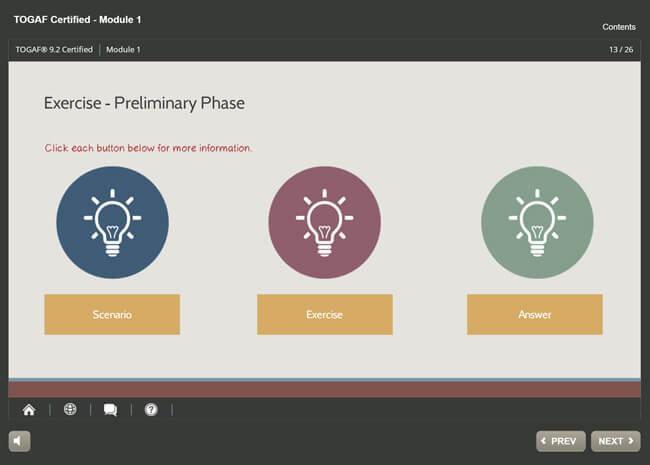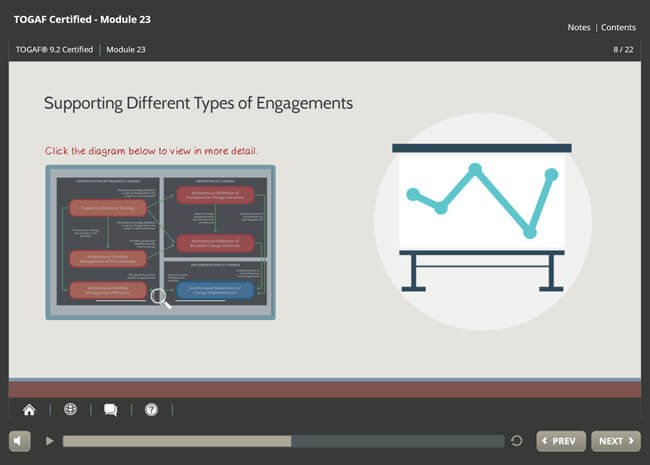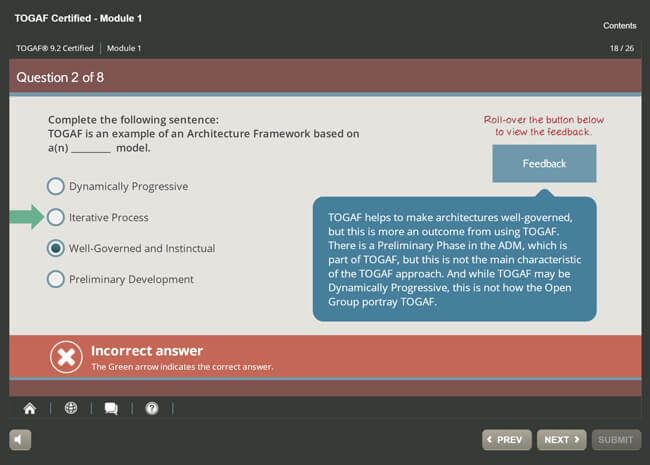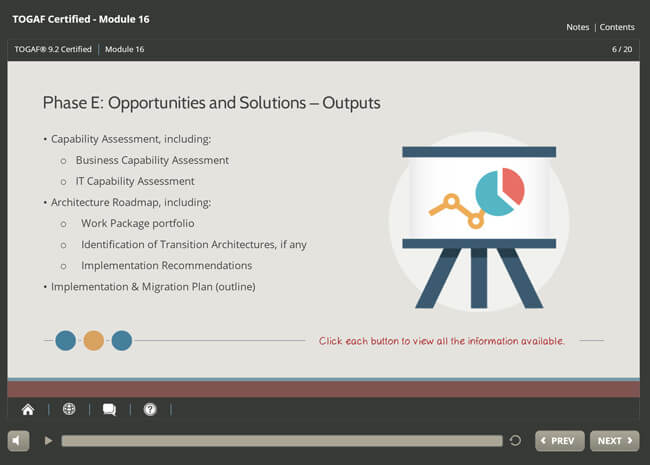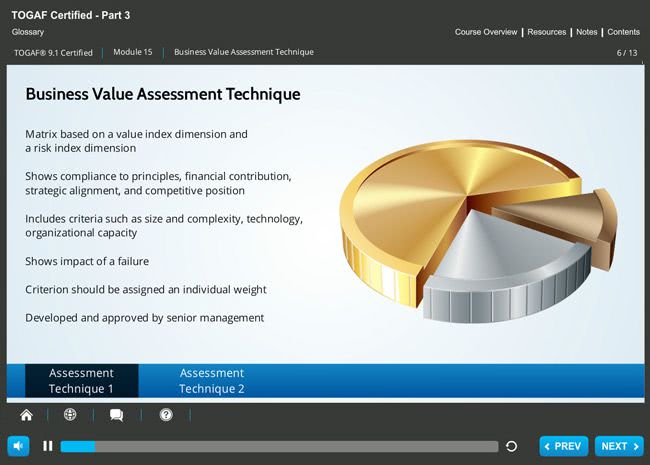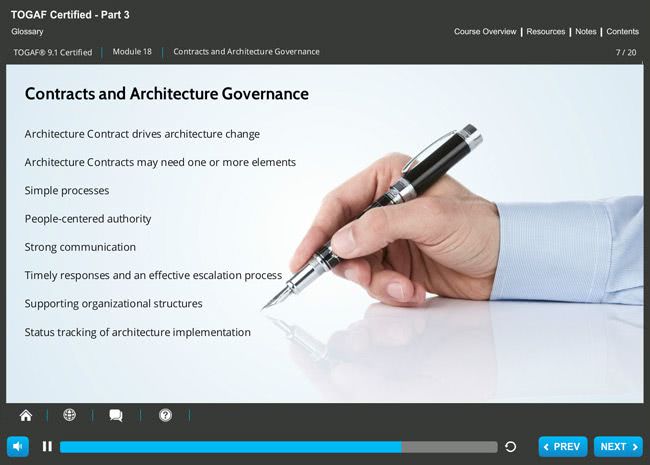Enterprise Architecture:
TOGAF® 9 Certified (Level 1 & 2)
12 months e-learning + exam voucher
€789 + VAT
“Every great building once begun as a building plan.
That means, sitting in that building plan on the table is a mighty structure not yet seen.
It is the same with dreams.”
– Israelmore Ayivor
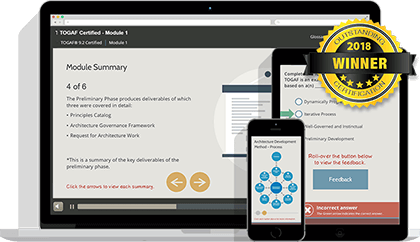
€789.00Add to cart
€789.00Add to cart
Enterprise Architecture:
TOGAF® 9 Certified (Level 1 & 2)
E-learning + Web-based examination
€789.00Add to cart
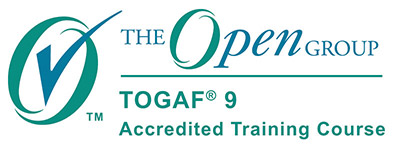
Key information about this course:
Price: 789 € + VAT ( 12 month E-learning + exam voucher)
- 35 hours of course material included
- Fully accredited by The Open Group
- Includes revision modules, practice exams, and 24/7 tutor support
- Instant 12 months access
- Downloadable PDF workbook
- Quizzes and revision modules
- Mock exam simulator with answers
- Award winning TOGAF training
- 1 x combined exam voucher on request
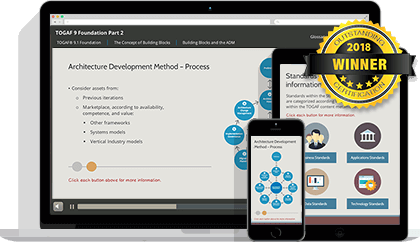
This course has been fully accredited by The Open Group and meets all the learning requirements of the latest version of TOGAF (9.2) in order for students to sit and pass the TOGAF Foundation (Level 1) and TOGAF Certified (Level 2) exams.
This fully accredited online course offers everything you need to pursue TOGAF 9.2 Certification. The TOGAF business enterprise architecture framework is world-renowned, and our course can help you pass the Foundation (level 1) and Certified (Level 2) examinations!
This award-winning Enterprise Architecture course, has been recognized at The Open Group Awards Ceremony in 2018. Our approach is self-paced, allowing students to work at their own speed and access content at any time, even from handheld devices! We also provide formative quizzes to help learners reinforce their knowledge retention after each module, as well as mock exams to help them prepare for the official certification examinations.
This course is ideal for anyone who wants to pass the TOGAF Foundation and Certified exams in quick succession in order to become a fully qualified TOGAF 9.2 Practitioner. Many students prefer this combined approach, as it means less time and money spent on training.
This course is created according to the TOGAF 9.2 Certification exam syllabus. It is fully accredited by The Open Group, self-paced and offers content spread across 26 modules. The course provides in-depth information on the core principles and concepts of the TOGAF framework, while also helping learners to analyze and apply their knowledge in preparation for the official exams.
Are you looking for an online architecture course and want to become fully TOGAF Certified? The course is aimed at those who already have some knowledge of TOGAF and want to learn more about TOGAF architecture. Passing the combined exam will make you an official TOGAF Certified Practitioner, with a globally-recognized qualification ideal for pursuing lucrative roles and networking opportunities in Enterprise Architecture.
The course syllabus includes all the core concepts of the TOGAF Framework and also shows you how to apply everything you learn in practical situations as a qualified TOGAF architect.
TOGAF® 9 Certified delivered by Good e-learning is a course accredited by The Open Group. ITS Partner promotes this course for Good e-Learning.
- The TOGAF® Standard, version 9.2 Foundation Workbook
- Why TOGAF Certification for People?
- The TOGAF Certification Program
- Enterprise Architecture Background
- Interview with Allen Brown – CEO of the Open Group
- Architecture in the TOGAF Context?
- TOGAF Background
- Architecture Types
- TOGAF 9 Components
- What is the Value of TOGAF as an Architecture Framework
- What is an Architecture Framework?
- TOGAF Components
- Describe the main objectives of each phase
- Briefly explain the approach undertaken for each phase
- Briefly explain how Requirements Management fits into the ADM cycle
- Describe the nature of the Requirements Management process
- To briefly explain the contents of Part III of TOGAF 9
- The need for Architecture Principles and where they are used within TOGAF
- The standard template for Architecture Principles and what makes a good Architecture Principle
- What a Business Scenario is, its purpose, and explain where Business Scenarios are used within the ADM cycle
- The purpose of Gap Analysis and describe the Gap Analysis technique
- Explain the term interoperability, and understand the use of Interoperability Requirements within the TOGAF ADM
- To understand the Business Transformation Readiness program and where Business Transformation Readiness is used within the ADM
- To understand the characteristics of Risk Management and where Risk Management is used within the TOGAF ADM and to understand Capability-Based Planning
- To define and explain the concepts of Stakeholders, Concerns, Architecture Views, and Architecture Viewpoints
- To describe a simple example of an architecture viewpoint and view
- To discuss the relationship between stakeholders, concerns, architecture views, and architecture viewpoints
- To describe the architecture view creation process
- To define what a building block is, and explain what makes a good building block
- To explain the distinction between Architecture Building Blocks and Solution Building Blocks
- To explain the use of building blocks in the ADM cycle
- To describe the characteristics of an Architecture Pattern
- To explain the role of architecture deliverables across the ADM cycle
- To briefly explain the purpose of key TOGAF deliverables such as Architecture Building Blocks, Architecture Contract, Architecture Principles, Architecture Vision, Compliance Assessment, or Statement of Architecture Work
- To explain what the Enterprise Continuum is
- Describe how it is used in organizing and developing an architecture
- To explain how the Enterprise Continuum promotes re-use of architecture artifacts
- Describe the constituents of the Enterprise Continuum
- To explain the purpose of the Enterprise Continuum
- To explain the purpose of the Architecture Continuum
- To list the stages of architecture evolution defined in the Architecture Continuum
- To explain the purpose of the Solutions Continuum
- To list the stages of architecture evolution defined in the Solutions Continuum
- To explain the relationship between the Enterprise Continuum and the TOGAF ADM
- To describe the Architecture Repository, and explain the relationship between the Enterprise Continuum and the Architecture Repository
- To describe the classes of information held in the Architecture Repository
- To list the three levels of the Architecture Landscape
- To explain the purpose of the Standards Information Base within the Architecture Repository
- To explain the role of the TRM as a Foundation Architecture
- To describe at a high-level the main components of the TOGAF TRM
- To explain the basic concepts of the III-RM
- To explain the relationship of the III-RM to the concept of Boundaryless Information Flow
- To explain the concept of Architecture Governance and explain why it is beneficial
- To describe the main components that make up an Architecture Governance framework
- To explain the need for establishment of an Architecture Board and list its responsibilities
- To explain the role of Architecture Contracts
- To explain the meaning of and need for Architecture Compliance
- To explain the purpose of Architecture Compliance Reviews and briefly describe the Architecture Compliance Review process
- To explain how the ADM can be used to establish an Architecture Capability
- Understand the inputs to the phase and be able to explain the following key elements: Architecture Frameworks, Business principles, business goals, and business drivers
- Explain the influence of pre-existing architectural inputs on the phase
- Understand the steps and be able to: Describe how to establish an enterprise architecture team and organization, identify and establish a set of Architecture Principles for a given scenario, discuss the appropriate considerations for tailoring the framework
- Understand the outputs and be able to explain the following key elements: Architecture Principles, Architecture Governance Framework, Request for Architecture Work
- Explain how Security Architecture influences this phase
- Explain how Architecture Governance fits within the ADM cycle
- Discuss the key success factors for putting Architecture Governance into practice
- Discuss the factors that should be considered when setting up an Architecture Board
- Explain how to operate an Architecture Board
- Describe the properties of a good Business Scenario
- Explain how to develop and validate a Business
- Describe the typical contents of the Architecture Repository at this point
- Understand the steps and be able to describe how to identify stakeholders, their concerns, and business requirements. As well as being able to explain the purpose of a Business Transformation Readiness Assessment and describe the risk assessment approach taken in this phase
- Understand the outputs and be able to explain the following key elements including their purpose: Statement of Architecture Work, Capability Assessment, Architecture Vision and Communications Plan
- Explain the Security Architecture influences on this phase
- Explain the purpose of the Architecture Content Framework
- Describe the main components of the Content Metamodel
- Describe the relationship between the Architecture Content Framework and the TOGAF ADM
- Describe the steps in developing a Stakeholder Map
- Describe the stakeholders and their concerns
- Use the example Stakeholder Map provided by the TOGAF Standard as a guideline to identify stakeholders
- Describe the core metamodel concepts
- Explain the purpose of dividing the metamodel into core and extensions
- Describe the key concepts related to the core metamodel entities
- Explain how to reconcile Interoperability Requirements with potential solutions
- Explain the factors that influence Business Transformation Readiness
- Explain how to determine requirements for risk assessments
- Explain how Capability-Based Planning is applied in an enterprise architecture context
- Understand the inputs to the phase and explain business principles, business goals, and business drivers
- Understand the steps and be able to: Describe three techniques for business modeling, explain the considerations for selecting reference models, viewpoints and tools, explain the technique of Gap Analysis
- Explain how building blocks are used in the development of the Business Architecture
- Understand the outputs and be able to explain the following key elements: Business Architecture components of the Architecture Definition Document, Business Architecture components of the Architecture Requirements Specification
- Explain the Security Architecture influences on this phase
- Explain the considerations for the implementation order of the Data and Application Architectures
- Understand the inputs to the phase and explain data principles
- Understand the steps and be able to explain the considerations for selecting reference models, viewpoints, and tools
- Understand the outputs and be able to explain the following key elements: Data Architecture components of the Architecture Definition Document, Data Architecture components of the Architecture Requirements Specification
- Explain the Security Architecture influences on this phase
- Understand the inputs to the phase and explain application principles
- Understand the steps and be able to explain the considerations for selecting reference models, viewpoints, and tools
- Understand the outputs and be able to explain the following key elements: Application Architecture components of the Architecture Definition Document, Application Architecture components of the Architecture Requirements Specification
- Explain the Security Architecture influences on this phase
- Explain the TRM graphic, including the following key elements: Application Software, Categories, Application Platform Interface, Application Platform, Communications Infrastructure Interface, Qualities
- Briefly describe the structure of the TRM
- Briefly explain the main architecture objectives of using the TRM
- Explain what the Platform Services Taxonomy is
- Explain what the Service Quality Taxonomy is
- Explain how to customize the TRM to meet an organization’s specific needs
- Describe the business and technical drivers for Boundaryless Information Flow
- Explain how the III-RM fulfills the solution space for Boundaryless Information Flow
- Briefly describe the high-level structure of the III-RM
- Explain the III-RM graphic, including the following components: Business Applications, Infrastructure Applications, Application Platform, Interfaces, Qualities
- Understand the inputs to the phase and explain the following key elements: Technology Principles
- Understand the steps and be able to: Explain how the TRM can be used when developing a Technology Architecture, Explain the role of ABBs
- Understand the outputs and be able to explain the following key elements: Technology Architecture components of the Architecture Definition Document, Technology Architecture components of the Architecture Requirements Specification
- Explain the Security Architecture influences on this phase
- Describe how the Implementation Factor Assessment and Deduction Matrix can be used to document factors impacting the Architecture Implementation and Migration Plan
- Explain the purpose of the Consolidated Gaps, Solutions, and Dependencies Matrix
- Describe the purpose of an Architecture Definition Increments Table
- Explain how the Transition Architecture State Evolution Table can be used in conjunction with a defined taxonomy such as the TOGAF Standards TRM
- Explain how the Business Value Assessment Technique can be used in architecture development
- Explain how migration planning techniques are used in this phase to review and consolidate the Gap Analysis results from earlier phases
- Describe the steps to create the Implementation and Migration Strategy
- Describe three basic approaches to implementation
- Explain how to identify and group work packages
- Explain how Transition Architectures are created and documented
- Describe the management frameworks that have to be coordinated within this phase
- Explain how business value is assigned to each work package
- Describe the steps to prioritize the migration projects
- Describe the steps to confirm the Architecture Roadmap
- Explain key outputs of this phase specifically: Implementation and Migration Plan, Architecture Definition Document, including Transition Architectures (if any)
- Explain the Security Architecture influences on this phase
- Understand the inputs to the phase
- Understand the steps and be able to describe the following: Explain how to tailor and conduct an Architecture Compliance Review
- Understand the outputs and be able to explain the following key elements: The contents of Architecture Contracts, their relationship to Architecture Governance
- Explain the Security Architecture influences on this phase
- Demonstrate the role that risk monitoring plays in this phase
- Understand the inputs to the phase and be able to explain the following: Change Requests
- Understand the steps and be able to describe the following: Architecture board meetings
- Understand the outputs and be able to explain when the following might occur: Updated Architecture Contracts, a new Request for Architecture Work
- Explain the Security Architecture influences on this phase
- Understand the inputs to the phase
- Understand the steps and their correspondence to phases
- Explain how the Requirements Management steps correspond to ADM phases
- Explain the purpose of the outputs of Requirements Management
- Explain the Security Architecture influences on the requirements captured
- Describe the purpose of Architecture Partitioning
- Describe the classification criteria for solutions and architectures when considering partitioning
- Describe how Architecture Partitioning can be employed in the Preliminary Phase of the ADM
- Explain the relationship between the Architecture Repository and the Enterprise Repository
- Describe the purpose of the repository areas that hold output of projects, specifically: Architecture Landscape, Reference Library, Standards Information Base
- Governance Log
- Describe the concept of iteration and how it applies to TOGAF standards
- Describe the factors influencing the use of iteration
- Describe some suggested iteration cycles
- Describe how the ADM supports different types of engagements within the organization
- Explain how to apply iteration cycles to the ADM phases
- Explain how the concepts of levels and the Enterprise Continuum are used to organize the Architecture Landscape
- Identify the different levels of architecture that exist in an organization
- Describe the responsibility that Enterprise Architects have towards Security Architecture
- Describe the recommended Security adaptations to the ADM
- Explain the role of a Capability Maturity Model
- Explain the CMMI process improvement approach development by CMU
- Describe the structure and levels of the ACMM developed by CMU for the US DoC
- Explain the role of Maturity Assessments in the ADM
- Explain the purpose of the Architecture Skills Framework and why it is needed
- Describe the benefits of using the Architecture Skills Framework
- Describe the structure of the Architecture Skills Framework, including roles, skills, and proficiency levels
What you need to know about the Foundation (Level 1) exam:
- This is a multiple choice exam consisting of 40 questions.
- There is a time limit of 60 minutes to complete the exam
- The exam is closed book – you cannot make use of any resources or materials during the exam
- To pass the exam you must get 22 out of 40 questions correct (55%)
- In countries where English is a second language, the time allocated for the exam is extended to 90 minutes
What you need to know about the Certified (Level 2) exam:
- This is an open book examination consisting of 8 questions
- There is a time limit of 90 minutes to complete the exam
- Each correct answer scores 5 points
- Each second-best answer scores 3 points
- Each third-best answer scores 1 point
- The pass mark for the exam is 60%: you must get 24 out of 40 questions correct
Pearson Vue are the authorized providers of exams for TOGAF, IT4IT and ArchiMate certification, and host exams worldwide through a network of test centers. We can provide you with a voucher for the Foundation level 1 and Certified Level 2 exam on request.
The exam voucher is valid for 12 months from the date of issue.
TOGAF 9.2 courses feature a student workbook, available as a PDF download. The student can use this workbook to make notes as they progress through the courses. A completed workbook makes a great resource for exam preparation.
Either print out the workbook and make hand-written entries, or (if you have Adobe Reader 11 or later) make notes directly into the PDF.
Each module concludes with a number of multiple choice questions that cover the information you have just engaged with. Use these opportunities to test your understanding and recall of the topics as you progress. Revisit the module until you are comfortable in answering the questions correctly. You can then move on to the next module with confidence.
One mock exam and mock exam simulator with answers is included within the course to prepare students to take the official exam as best possible.
TOGAF® 9 Certified delivered by Good e-learning is a course accredited by The Open Group. ITS Partner promotes this course for Good e-Learning

